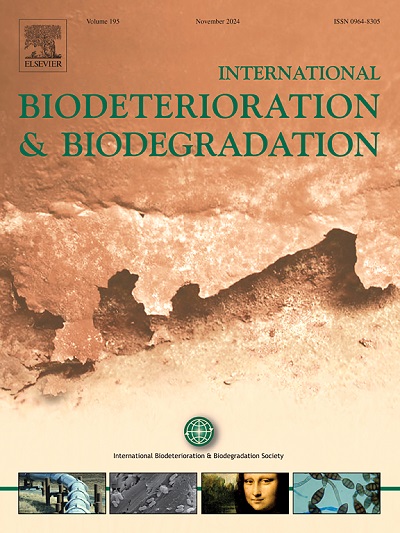地衣芽孢杆菌SP01形成聚合物凝胶后残留Cr3+对部分水解聚丙烯酰胺生物降解的影响
IF 4.1
2区 环境科学与生态学
Q2 BIOTECHNOLOGY & APPLIED MICROBIOLOGY
International Biodeterioration & Biodegradation
Pub Date : 2025-07-23
DOI:10.1016/j.ibiod.2025.106163
引用次数: 0
摘要
聚合物凝胶形成后残留的部分水解聚丙烯酰胺(HPAM)和交联剂(Cr3+)会造成堵塞,降低回收率。微生物可以降解HPAM来解决问题,但Cr3+抑制了这一过程,从而降低了原油采收率。本研究探讨了一个未被开发的领域-在Cr3+存在下HPAM的生物降解。创新地将HPAM和原油分别作为唯一的氮(N)源和碳(C)源,从大庆油田生产水中分离出生长最快的菌株,鉴定为地衣芽孢杆菌SP01。傅里叶变换红外光谱、高效液相色谱和扫描电镜分析揭示了Cr3+诱导HPAM生物降解后的结构和形态变化。B. licheniformis SP01对HPAM的最大降解率为39.66%,Cr3+对HPAM的降解率为32.41%,降低了7.25%。与此同时,生物量下降43.9%,酰胺酶和脲酶活性分别下降35.2%和19.5%,这表明Cr3+损害了微生物生长和酶活性,从而降低了HPAM的生物降解。HPAM中C和N的质量平衡和化学计量学研究表明,Cr3+改变了HPAM的生物降解途径和最终降解产物。此外,本研究还探讨了储层条件对残余Cr3+生物降解的影响,并预测了最佳降解率为37.10%。这些结果突出了Cr3+对HPAM生物降解机制的抑制作用,并提出了缓解储层堵塞、提高聚合物凝胶形成后采收率的生物修复策略。本文章由计算机程序翻译,如有差异,请以英文原文为准。

Residual Cr3+ on the biodegradation of partially hydrolyzed polyacrylamide after polymer gel formation by Bacillus licheniformis SP01
The residual Partially Hydrolyzed Polyacrylamide (HPAM) and the crosslinker (Cr3+) after polymer gel formation caused blockages and decreased recovery. Microorganisms can degrade HPAM to address the issues, but Cr3+ inhibits the process and consequently reduces oil recovery. This study investigates an underexplored area—the biodegradation of HPAM in the presence of Cr3+. HPAM and crude oil were innovatively used as the sole nitrogen(N) and carbon(C) sources, respectively, to isolate the highest-growing strain from Daqing Oilfield production water, identified as Bacillus licheniformis SP01. Fourier transform infrared spectroscopy, high-performance liquid chromatography and scanning electron microscopy analyses revealed Cr3+-induced structural and morphological changes in HPAM after biodegradation. B. licheniformis SP01 exhibited a maximum HPAM degradation rate of 39.66 %, which declined to 32.41 % (a 7.25 % decrease) upon exposure to Cr3+. This was accompanied by a 43.9 % drop in biomass and declines in amidase and urease activity by 35.2 % and 19.5 %, respectively, implying that Cr3+ impairs microbial growth and enzymatic activities, thereby reducing HPAM biodegradation. Mass balance and stoichiometry investigations of C and N in HPAM indicate that Cr3+ alters both the biodegradation pathway and final degradation products. Furthermore, this study explores the impact of reservoir conditions on biodegradation with residual Cr3+ present and predict the optimal degradation rate of 37.10 %. These results highlight the inhibitory effects of Cr3+ on HPAM biodegradation mechanism and propose a bioremediation strategy to mitigate reservoir plugging, improving oil recovery after polymer gel formation.
求助全文
通过发布文献求助,成功后即可免费获取论文全文。
去求助
来源期刊
CiteScore
9.60
自引率
10.40%
发文量
107
审稿时长
21 days
期刊介绍:
International Biodeterioration and Biodegradation publishes original research papers and reviews on the biological causes of deterioration or degradation.

 求助内容:
求助内容: 应助结果提醒方式:
应助结果提醒方式:


